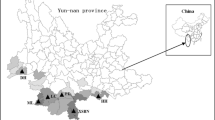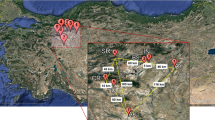Abstract
Dendrobium officinale is a rare and endangered herb with special habitats and endemic to China. Genetic diversity was examined within and among nine natural populations using inter-simple sequence repeat (ISSR) and random amplified polymorphic (RAPD) for conservation. Both molecular markers revealed a high percentage (>89%) of polymorphic bands and ISSR markers detected more diversity than RAPD markers. Analysis of molecular variance (AMOVA) revealed that 78.84% (ISSR) and 78.88% (RAPD) of variability was partitioned among individuals within populations. This genetic structure was probably due to severe genetic drift resulting from habitat fragmentation and human overexploitation since 1950s. Moreover, there is a lack of significant association between genetic and geographic distances (r = 0.276; p > 0.05) in the populations of D. officinale. From the conservation point of view, populations GL, GS and GSD with higher genetic diversity should be protected firstly to maintain the species potential for evolutionary change and population YG with lower diversity but representing a novel evolutionary unit should also be paid more attention to during D. officinale conservation practice.
Similar content being viewed by others
References
Shrestha, M.K., Golan-Goldhirsh, A., and Ward, D., Population Genetic Structure and the Conservation of Isolated Populations of Acacia raddeana in the Negev Desert, Biol. Conserv., 2002, vol. 108, no. 1, pp. 119–127.
Hogbin, P.M., Ayre, D.J., and Whelan, R.J., Genetic Variation and Reproductive Success of Road Verge Populations of the Rare Shrub Grevillea barklyana (Proteaceae), Heredity, 1998, vol. 80, pp. 180–186.
Jian, S.G., Zhong, Y., Liu, N., et al., Genetic Variation in the Endangered Endemic Species Cycas fairylakea (Cycadaceae) in China and Implications for Conservation, Biodivers. Conserv., 2006, vol. 15, no. 5, pp. 1681–1694.
Zawko, G., Krauss, S.L., Dixon, K.W., and Sivasithamparam, K., Conservation Genetics of the Rare and Endangered Leucopogon obtectus (Ericaceae), Mol. Ecol., 2001, vol. 10, pp. 2389–2396.
Premoli, A.C., Kitzberger, T., and Veblen, T.T., Conservation Genetics of the Endangered Conifer Fitzroya cupressoides in Chile and Argentina, Conserv. Genet., 2000, vol. 1, no. 1, pp. 57–66.
The Pharmacopoeia Commission of PRC: Pharmacopoeia of the People’s Republic of China, Beijing: Chemical Industry Press, 2000.
Ding, X.Y., Xu, L.S., Wang, Z.T., et al., Authentication of Stems of Dendrobium officinale by rDNA ITS Region Sequences, Planta Med., 2002, vol. 68, no. 2, pp. 191–192.
Fu, L.G., Chinese Plant Red Book, Bejing: Science Press, 1992.
Kochieva, E.Z., Ryzhova, N.N., Legkobit, M.P., and Khadeeva, N.V., RAPD and ISSR Analyses of Species and Populations of the Genus Stachys, Russ. J. Genet., 2006, vol. 42, no. 7, pp. 887–892.
Ge, X.J., Yu, Y., Zhao, N.X., et al., Genetic Variation in the Endangered Inner Mongolia Endemic Shrub Tetraena mongolica Maxim. (Zygophyllaceae), Biol. Conserv., 2003, vol. 111, no. 3, pp. 427–434.
Williams, J.G.K., Kubelik, A.R., Livak, K.J., et al., DNA Polymorphisms Amplified by Arbitrary Primers are Useful as Genetic Markers, Nucleic Acids Res., 1990, vol. 18, no. 22, pp. 6531–6535.
Artyukova, E.V., Kozyreko, M.M., Koren, O.G., et al., RAPD and Allozyme Analysis of Genetic Diversity in Panax ginseng C.A. Meyer and P. quinquefolius L., Russ. J. Genet., 2004, vol. 40, no. 2, pp. 239–247.
Wang, J.L., Zhao, N.X., Gai, Y.B., et al., RAPD Analysis of Genetic Diversity and Population Genetic Structure of Stipa krylovii Reshov. in Inner Mongolia Steppe, Russ. J. Genet., 2006, vol. 42, no. 5, pp. 468–475.
Yeh, F.C., Yang, R.C., and Boyle, T., POPGENE. Microsoft Windows-Based Freeware for Population Genetic Analysis: Release 1.31, Edmonton: Univ. Alberta, 1999.
Nei, M., Analysis of Gene Diversity in Subdivided Populations, Proc. Natl. Acad. Sci. USA, 1973, vol. 70, no. 12, pp. 3321–3323.
Nei, M., Genetic Distance between Populations, Am. Naturalist, 1972, vol. 106, no. 949, pp. 283–292.
Lewontin, R.C., The Apportionment of Human Diversity, Evol. Biol., 1972, vol. 6, pp. 381–398.
Wright, S., Evolution and Genetics of Populations: Variability within and among Natural Populations, Chicago: Univ. Chicago Press, 1978, vol. 4.
Excoffier, L., Smouse, P., and Quattro, J., Analysis of Molecular Variance Inferred from Metric Distances among DNA Haplotypes: Application to Human Mitochondrial DNA Restriction Data, Genetics, 1992, vol. 131, no. 2, pp. 479–491.
Miller, M.P., AMOVA-PREP: A Program for the Preparation of AMOVA Input Files from Dominant-Marker Raw Data, Release 1.01, Flagstaff: Northern Arizona Univ., 1998.
Rohlf, F.J., NTSYS-Pc, Numerical Taxonomy and Multivariate Analysis System: Version 2.1, New York: Exeter Software, 2000.
Slatkin, M. and Hudson, R.R., Pairwise Comparisons of Mitochondrial DNA Sequences in Stable and Exponentially Growing Populations, Genetics, 1991, vol. 129, no. 2, pp. 555–562.
Schneider, S., Roessli, D., and Excoffier, L., ARLEQUIN, Version 2.000: A Software for Population Genetics Data Analysis, Geneva: Univ. Geneva, 2000.
Tajima, F., Statistical Method for Testing the Neutral Mutation Hypothesis by DNA Polymorphism, Genetics, 1989, vol. 123, no. 3, pp. 585–595.
Fu, Y.X., Statistical Tests of Neutrality of Mutations against Population Growth, Hitchhiking and Background Selection, Genetics, 1997, vol. 147, no. 2, pp. 915–925.
Li, Y.Y., Chen, X.Y., Zhang, X., et al., Genetic Differences between Wild and Artificial Populations of Metasequoia glyptostroboides: Implications for Species Recovery, Conserv. Biol., 2005, vol. 19, no. 1, pp. 224–231.
Maguire, T.L. and Sedgley, M., Genetic Diversity in Banksia and Dryandra (Proteaceae) with Emphasis on Banksia cuneata, a Rare and Endangered Species, Heredity, 1997, vol. 79, no. 4, pp. 394–401.
Fischer, M., Husi, R., Prati, D., et al., RAPD Variation among and within Small and Large Populations of the Rare Clonal Plant Ranunculus reptans (Ranunculaceae), Am. J. Botany, 2000, vol. 87, no. 8, pp. 1128–1137.
Real, L.A., Ecological Genetics, Princeton: Princeton Univ. Press, 1994.
Zhang, M., Xia, H.X., Zhu, L.Q., and Zhang, Y.J., Research Progress of Dendrobium Tissue Culture, China J. Chinese Materia. Medic., 2000, vol. 25, no. 6, pp. 323–326.
Marshall, D.R. and Brown, A.H.D., Optimum Sampling Strategies, Genetic Conservation, Crop Genetic Resource for Today and Tomorrow, Frankel, O.H., and Hawkes, J.G., Eds., Cambrige: Cambrige Univ. Press, 1975, pp. 53–80.
Goodman, D., The Demography of Chance Extinction, Viable Population for Conservation, Soule, M.E., Ed., Cambrigde: Cambrige Univ. Press, 1987, pp. 11–34.
Waser, N.M., Population Structure, Optimal Outbreeding, and Assortative Mating in Angiosperms, The Natural History of Inbreeding and Outbreeding: Theoretical and Empirical Perspectives, Thornhill, N.W, Ed., Chicago: Univ. of Chicago, 1993, pp. 173–199.
Author information
Authors and Affiliations
Corresponding author
Additional information
Published in Russian in Genetika, 2009, Vol. 45, No. 3, pp. 375–382.
The article is published in the original.
Rights and permissions
About this article
Cite this article
Ding, G., Li, X., Ding, X. et al. Genetic diversity across natural populations of Dendrobium officinale, the endangered medicinal herb endemic to China, revealed by ISSR and RAPD markers. Russ J Genet 45, 327–334 (2009). https://doi.org/10.1134/S1022795409030119
Received:
Published:
Issue Date:
DOI: https://doi.org/10.1134/S1022795409030119




